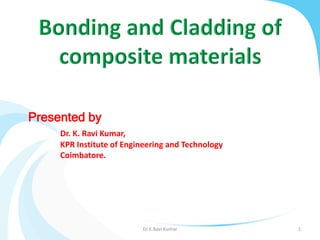
Bonding and Cladding of composite materials.pptx
- 1. 1 Presented by Dr. K. Ravi Kumar, KPR Institute of Engineering and Technology Coimbatore. Dr.K.Ravi Kumar
- 2. Cladding • Cladding - Metallurgical process in which layers of metal having different properties are bonded together to form a composite material . • Does not use any fillers or adhesive materials. • Bonding takes place with the help of extreme pressure in presence or absence of heat. • Capable of producing metals with two layers, three layers and upto seven layers or even more depending on the materials. 2 Dr.K.Ravi Kumar
- 3. Cladding Cladding metallic bonding generally involves three-stages namely: • Establishment of physical contact • Activation of contact surfaces • Interaction within joining metals by hot or cold process Caldding Methods • Roll Bonding • Accumulative Rolling Bonding • Friction Surface cladding • Laser Cladding • Microwave cladding • Rotary swaging • Plasma Surface Cladding 3 Dr.K.Ravi Kumar
- 4. Roll Bonding • Solid phase process in which the metals are bonded by rolling at an applied pressure. • Layer of two or more metals in the form of sheets, strips or plates are piled over each other. • • Roll bonded to achieve an appropriate bonding between the metals. 4 Dr.K.Ravi Kumar
- 5. Roll bonding parameters • Suitable for ductile materials • A maximum of 50 % reduction in thickness or sometimes even higher than that can be achieved in a single rolling pass. The roll bonding parameters: • nature of base metal • bonding temperature • rolling pressure • bonding time • surface preparation • layer thickness • number of layers • rolling speed • post and pre heat treatment • stacking sequence etc. 5 Dr.K.Ravi Kumar
- 7. Accumulative Roll Bonding Dr.K.Ravi Kumar 7
- 8. Friction Surface cladding Cladding takes place due to (1) the clad material deposits on the top of the substrate and forms a non-intermixed layer that contains the clad material only (2) Portion of the substrate gets mixed with the rod to form a layer. (3) Heat is generated by (1) the friction between substrate and rotating rods (2) friction at the boundary of the tool with the clad layer on the work piece. (4) The interface between the tool and the substrate influences the thickness of the clad layer. 8 Dr.K.Ravi Kumar
- 9. Friction Surface cladding parameters • Shape of ring formed at the rod tip and rod diameter • Axial force, spindle speed and table traverse speed • Process temperature • Heat affected zone • Cooling rate of the material during and after processing • A wide range of material like aluminium, magnesium and titanium alloys can be deposited by friction surfacing on alloys and stainless steels 9 Dr.K.Ravi Kumar
- 10. Laser Cladding • The coating material can be pre placed on the substrate by powder injection or by wire feeding. • Laser cladding is a powder deposition technology where the powder is blown through a nozzle on the work piece surface. 10 Dr.K.Ravi Kumar
- 11. Laser Cladding parameters • Average power size • Spot Size • Wave Length • Velocity of motion • Substrate geometry • Clad powder size • Clad powder feed rate • Nozzle Specifications • Coatings on titanium alloy by laser cladding using SiC, B4C and Y2O3 as clad materials revealed that coatings are reinforced by materials like NiTi, Cr7C3, CoTi, TiB2, CoTi2, Cr7C3, TiC, TiB, TiC, and Ti5Si3 11 Dr.K.Ravi Kumar
- 12. Microwave cladding • Charcoal is used as a suspector material, to make clad powders to interact with microwaves. • Experimental were carried in microwave oven at frequencies around 2.45 GHz and around 900 W. • • Time of the cladding process varies from 180 Seconds to 420 Seconds based on the cladding thickness. • The microwave cladding is suitable for cladding mainly Austenitic steels of different grades, copper, aluminium with reinforcements like Nickel, Tungsten and silicon carbide. 12 Dr.K.Ravi Kumar
- 14. Rotary swaging • Rotary swaging is a precision forming process normally used for forming tubes, bars and other cylindrical components. • Rotary swaging is used for producing solid cylindrical, hollow and solid parts where the axis can be elongated. • The rotary swaging process involves two categories (i) extrusion of the work piece, by forcing it into the die (ii) using two or more dies to hammer the work piece. 14 Dr.K.Ravi Kumar
- 15. Plasma Surface Cladding • The plasma beam is used for melting the cladding powder and the substrate. • Mixture of nickel coated tungsten carbide coatings and Nickel- based alloys were coated on a steel substrate by a high temperature plasma jet exhibited good boding 15 Dr.K.Ravi Kumar
- 16. Plasma Surface Cladding parameters • scanning velocity • Current • Voltage • Powder feeding rate • Plasma gas flow • Plasma arc length etc. 16 Dr.K.Ravi Kumar